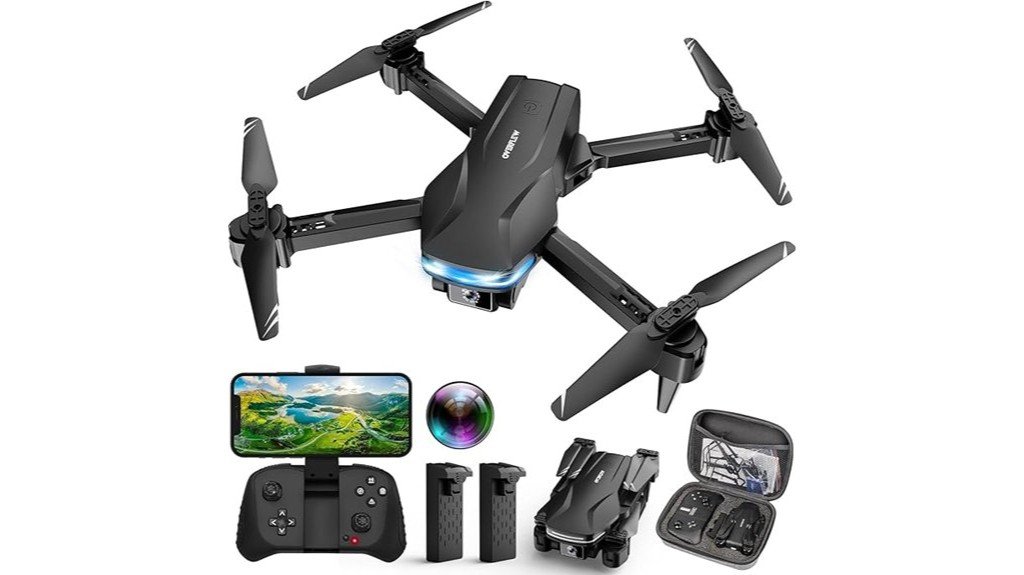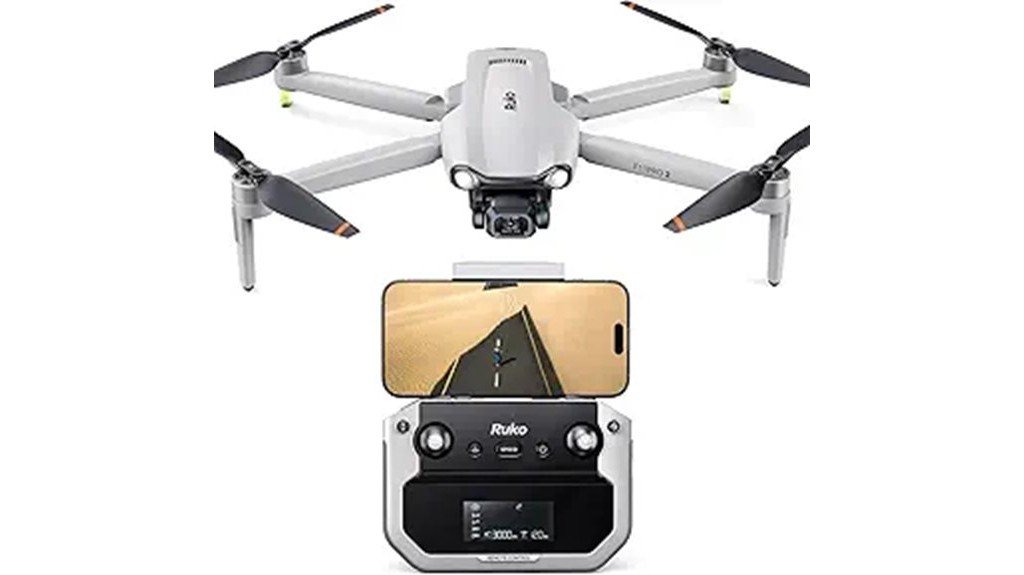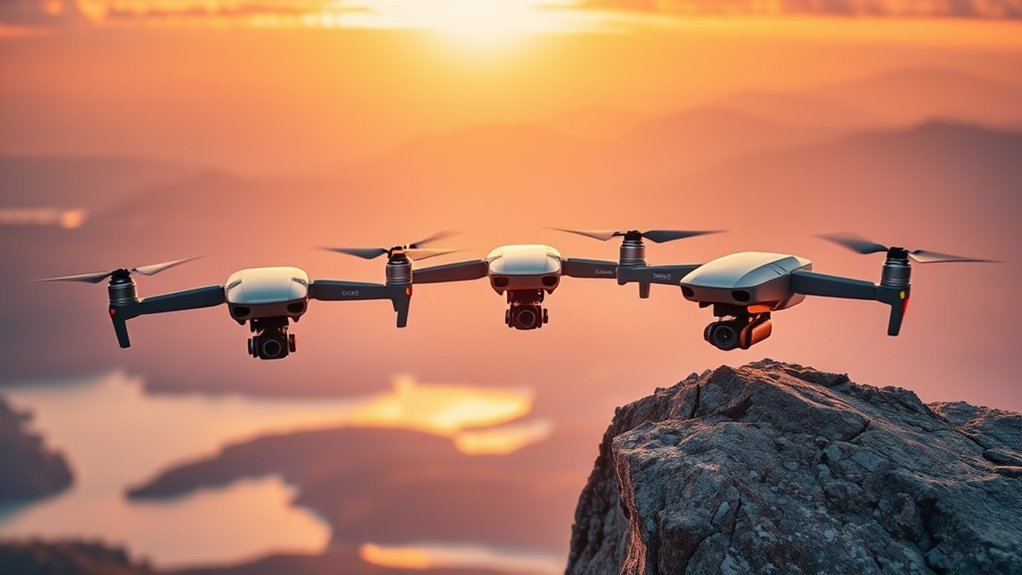Did you know that drone technology has evolved rapidly, making it easier than ever to capture professional-quality video? In 2025, three standout models are making waves for their impressive features and capabilities. Whether you’re a beginner or a seasoned pro, these drones offer something unique. Curious about what sets them apart? Let’s explore the top contenders for your next aerial adventure.
DJI Mini 4K Drone with 4K UHD Camera

The DJI Mini 4K Drone with 4K UHD Camera is ideal for content creators seeking high-quality video without the hassle of FAA registration, thanks to its lightweight design of under 249 grams. With a wind resistance of up to 38 kph and an altitude capability of 4,000 meters, you can easily capture stunning footage in various conditions. The 3-axis gimbal guarantees your videos are smooth and cinematic, no matter the lighting. Plus, you’ll appreciate the user-friendly features like one-tap takeoff and GPS Return to Home. With battery options providing up to 93 minutes of flight time, you’ll never miss a moment.
Best For: Content creators and hobbyists looking for a lightweight, easy-to-use drone that delivers high-quality 4K video footage without the need for FAA registration.
Pros:
- Lightweight design under 249 g eliminates the need for FAA registration.
- 3-axis gimbal stabilization ensures smooth, cinematic video quality.
- User-friendly features such as one-tap takeoff and GPS Return to Home make it accessible for beginners.
Cons:
- Limited flight time with a single battery may require additional purchases for extended use.
- Wind resistance may be insufficient for flying in very windy conditions.
- The camera’s performance in extreme low-light situations may not match that of higher-end models.
Drone with Camera 1080P HD FPV Foldable Quadcopter for Beginners and Kids

Looking for an ideal drone for beginners and kids? The Velcase S101 Drone offers a fantastic 1080P HD camera, perfect for capturing stunning footage. Weighing just 1.17 pounds, its foldable design makes it super portable. You’ll enjoy features like one-key takeoff, headless mode, and 360° flips, all ensuring an easy flying experience. With a flight time of up to 26 minutes thanks to two batteries, you won’t miss a moment. The included propeller guards enhance safety during playtime. Plus, with 24-hour tech support, you can fly with confidence. This drone is a great choice for budding pilots!
Best For: Beginners and kids looking for an easy-to-fly drone with a quality camera for capturing aerial footage.
Pros:
- Easy to operate with features like one-key takeoff and headless mode, making it beginner-friendly.
- Equipped with a 1080P HD camera for high-quality video and photo capture.
- Foldable design and lightweight build enhance portability for outdoor adventures.
Cons:
- Limited flight time of 26 minutes may require frequent battery changes.
- May not perform as well in windy conditions due to its lightweight design.
- The camera quality, while good, may not meet the expectations of more experienced drone users.
Ruko F11PRO 2 Drone with 6K Camera

For those seeking to elevate their videography game, the Ruko F11PRO 2 Drone with a 6K camera is a top contender in 2025. You’ll appreciate its stunning 6K photos and 4K/30fps video capture, showcasing vibrant colors and exceptional clarity. The 3-axis brushless gimbal guarantees smooth, stable shots, while the advanced night mode lets you capture breathtaking visuals after dark. With intelligent GPS flight modes like follow-me and waypoint planning, even beginners can create professional-level footage. Plus, enjoy up to 70 minutes of flight time, making it perfect for capturing family moments or backyard adventures. Don’t miss this cinematic treasure!
Best For: Those looking to enhance their videography skills, from beginners capturing family moments to experienced users seeking professional-level footage.
Pros:
- Stunning image quality with 6K photos and 4K/30fps video capture, providing vibrant colors and exceptional clarity.
- User-friendly intelligent GPS flight modes make it easy for beginners to create cinematic shots without extensive experience.
- Extended flight time of up to 70 minutes with two batteries, allowing for longer shooting sessions.
Cons:
- Optimal charging requires using the Ruko charger only, which may limit convenience.
- Heavy reliance on GPS for intelligent flight modes might affect performance in areas with poor signal.
- Limited to a specific output voltage for charging, which can be a hassle if you’re used to universal chargers.
Factors to Consider When Choosing Drones for Video
When you’re choosing a drone for video, you’ll want to focus on key factors that can make or break your footage. Consider the camera resolution, stabilization technology, and flight time to guarantee you capture the best shots. User-friendly features and intelligent flight modes can also enhance your overall experience, so keep those in mind too.
Camera Resolution Importance
Clarity in video quality hinges on camera resolution, making it a key factor in choosing drones for capturing stunning footage. Opting for higher resolutions like 4K or 6K gives you sharper, more detailed visuals compared to standard 1080p. A 4K Ultra HD camera, for instance, captures video at 3840×2160 pixels, delivering four times the detail of 1080p. This higher resolution is essential for large displays and professional projects, as it maintains clarity even when zoomed in or cropped. Additionally, consider the sensor quality and lens, as these elements greatly impact overall image quality, including color vibrancy and detail. If you’re filming at night, look for cameras with night mode capabilities to enhance low-light video capture.
Stabilization Technology Used
To achieve stunning video footage, understanding the importance of stabilization technology is essential. Effective stabilization, like a 3-axis gimbal, helps you capture smooth, cinematic-quality video by minimizing vibrations and sudden movements during flight. Drones with advanced stabilization systems excel in windy conditions, ensuring high video quality even in gusts. This technology also enhances low-light performance, allowing you to record clear footage during challenging lighting, such as at dusk or dawn. When planning to shoot dynamic scenes, like sports events, consider the drone’s stabilization features for peak performance. High-quality stabilization can greatly reduce the need for post-production editing, saving you time and effort in video production. Choose wisely, and elevate your video game!
Flight Time Considerations
While stabilization technology helps achieve smooth video footage, flight time plays a crucial role in your overall shooting experience. You’ll want a drone that offers adequate flight time to capture the shots you need without constant interruptions. Entry-level drones usually provide around 26 minutes, while higher-end models can extend up to 70 minutes with multiple batteries. Longer battery life reduces anxiety, allowing for more creative freedom during your aerial sessions. If you opt for drones with multiple battery options, you can greatly enhance your total flight duration. Don’t forget to take into account wind resistance as well; strong winds can drain battery life quickly. Finally, specialized chargers can optimize performance, ensuring your drone stays efficient on longer shoots.
User-Friendly Features
When choosing a drone for video, user-friendly features can make all the difference, especially if you’re new to flying. Look for drones with one-tap takeoff and landing to simplify your experience. Also, verify your drone has GPS Return to Home (RTH) functionality, which automatically brings it back to the takeoff point, helping you avoid loss. Stability features like barometric altitude hold and optical flow positioning enhance hover stability and control, making your flights smoother. Additionally, check for in-app learning resources that offer tutorials and guidance, helping you master flight techniques quickly. These user-friendly elements will boost your confidence and allow you to focus on capturing stunning footage, even if you’re just starting out.
Intelligent Flight Modes
How can intelligent flight modes elevate your video capture experience? These features, like follow-me and waypoint planning, allow your drone to autonomously capture complex shots while you focus on composition. With options like QuickShots, you can create cinematic footage with just a tap, regardless of your flying experience. Advanced modes, such as orbit flight and cruise control, enable dynamic aerial movements that enrich your storytelling. If you’re a beginner, drones with intelligent flight modes simplify operation, helping you achieve professional-level video quality easily. By utilizing these modes, you reveal creative possibilities, capturing unique angles and perspectives that would be challenging to achieve manually. Elevate your videography with these smart features and make your footage stand out.
Weight and Portability
Choosing the right drone for video often hinges on weight and portability. Lighter drones, especially those under 249 grams, don’t require FAA registration, making them easier to transport. You’ll appreciate how convenient it is to pack a lightweight drone in your backpack or a small case for spontaneous shoots. Foldable designs enhance portability, allowing you to minimize space when you’re on the move. While lighter drones are easier to carry, remember that heavier models often offer better stability and wind resistance, resulting in smoother footage. Also, consider battery weight, as lighter batteries can lead to longer flight times without adding too much heft. Balancing these factors is key to capturing stunning video effortlessly.
Safety Features Included
As you consider weight and portability in your drone selection, don’t overlook the importance of safety features. Low battery warnings are essential; they prevent mid-flight crashes by ensuring your drone returns safely before power runs out. Built-in overcurrent protection safeguards the electrical components during operation, enhancing safety overall. Propeller guards can minimize injury risks and protect your drone’s propellers from damage during collisions. Features like optical flow positioning and barometric altitude hold provide stable flight, reducing the chance of accidents from sudden altitude changes. Finally, headless mode simplifies navigation for beginners, allowing for easier control without worrying about orientation. Prioritizing these safety features will help you enjoy a secure flying experience while capturing stunning video footage.

